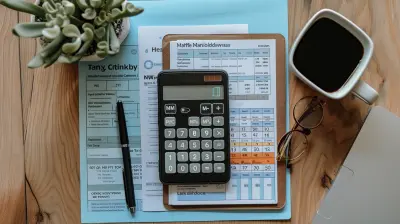The Essential Guide to Employer 401k Matching Contributions
22 October 2025
Let’s talk about free money. Yep, you heard that right—free money. It might sound too good to be true, but if your employer offers a 401(k) match and you're not taking full advantage of it, you're literally leaving cash on the table. Whether you're just getting started with your first job or trying to get your financial act together later in life, understanding how employer 401(k) matching works can be a total game-changer for your future financial security.
In this guide, we're going to break it all down in simple terms—no financial jargon, just real talk. By the time you’re done reading, you’ll know what a 401(k) match is, how to use it to your advantage, and why not taking full advantage of it is like ignoring a winning lottery ticket.
What Is a 401(k) Match Anyway?
Let’s start at square one. A 401(k) is a retirement savings plan offered by many employers. You contribute a portion of your paycheck, before taxes, into your account. The cool part? Sometimes your employer chips in too. That’s the “match.”Think of it like this: You’re at a pizza party (stay with me here), and someone says, "For every slice you grab, I’ll grab another one for you." That’s the match. More pizza. More savings.
So, your employer is essentially saying, “Hey, if you’re serious about saving for your future, I’ll help you out.” Now, who wouldn’t want that?
How Does Employer 401(k) Matching Work?
This is where things get mildly technical, but hang with me.Most company matches follow a percentage system. For example, your employer might match 100% of your contributions up to 4% of your salary. If you're earning $60,000 a year and contribute 4% ($2,400), your employer kicks in another $2,400. That’s $4,800 total saved in one year—and you only had to put in half!
There are lots of variations, though. Some employers do:
- Dollar-for-dollar matches: They match every dollar you contribute up to a certain percentage.
- Partial matches: They might give you $0.50 for every $1.00 you contribute, up to a limit.
- Tiered matches: A bit of this and a bit of that—like matching 100% of the first 3%, then 50% of the next 2%, and so on.
It differs company to company, so your job? Read the fine print. Ask HR. Don’t assume it’s all the same.
The Importance of Maxing Out the Match
Let me put it this way—if your boss walked up and offered you a few grand at the end of the year and all you had to do was save a portion of your salary, would you say no?That’s exactly what’s happening with a 401(k) match.
Not taking advantage of the full match is like turning down part of your salary. Imagine you’re making $60K a year, and your company offers a 5% match. That’s $3,000 of extra savings annually. If you don’t contribute enough to get that match, you’re missing out on that $3,000. Multiply that over 30 years (not even counting investment growth), and that’s $90,000 gone. Poof.
Even Dave Ramsey or Suze Orman would be wagging their fingers at you.
Vesting: When Does the Free Money Become Yours?
Okay, here’s the catch—and yeah, there’s always a catch, right?Enter: vesting.
Some companies want to make sure you stick around, so they use a vesting schedule. This means you don’t own your employer’s matching contributions right away. You own your own contributions immediately (that’s called being 100% vested in your contributions), but what your employer gives you? That might take time.
There are two common types of vesting:
- Cliff Vesting: You’re not entitled to any of the match until a certain period (say, 3 years), and then boom—you get it all at once.
- Graded Vesting: You gradually earn ownership over time. Maybe 20% after one year, 40% after two, and so on.
So what does this mean for you? Check your company’s vesting schedule. If you’re planning to job-hop next year, you may want to think twice if you’re close to being fully vested.
Why 401(k) Matching Is a Big Deal (Especially for Millennials and Gen Z)
Let’s face it—saving for retirement can feel like planning for next Christmas while you’re still unpacking from last year’s gifts. With student loans, rent, and inflation, it’s easy to think, “I’ll worry about retirement later.”But here’s the truth: your future self will thank you, big time.
Receiving matching contributions is like hitting the investor jackpot in your 20s and 30s. Why? Because of compound growth. When the money grows on itself—and then that growth grows some more—it’s a beautiful thing.
Let’s play with numbers for a sec:
If you put in $3,000 a year and your employer matches $3,000, and your investment grows at an average of 7% annually, in 30 years, you’d have over $600,000. And again, you only deposited half.
That’s magic. Well, math actually—but magic with numbers.
What If Your Employer Doesn’t Offer a Match?
Not all companies offer a 401(k) match, and that’s a bummer. But don’t let that stop you from saving.Even without a match, a 401(k) is still a solid retirement tool thanks to its tax advantages. Contributions reduce your taxable income now, and your money grows tax-deferred until you withdraw it in retirement.
And if your employer offers a Roth 401(k) option? Even better. That allows you to contribute after-tax dollars now, so you can enjoy tax-free withdrawals later. Basically, it's prepaid tax for your retired self.
If there’s no 401(k) match available, you might also consider:
- An IRA (Traditional or Roth)
- A high-yield savings account for an emergency fund
- Talking to your employer about adding a match (hey, it doesn’t hurt to ask)
Common Mistakes to Avoid With Employer 401(k) Matching
Alright, time for some real talk. Here are some of the top mistakes folks make when it comes to employer 401(k) matches:1. Not contributing enough to get the full match
This one’s huge. If your employer matches up to 5%, contribute at least that. Otherwise, you’re walking away from free cash.2. Failing to understand vesting schedules
If you leave a job too early, you might forfeit part—or all—of the match. Know the rules before jumping ship.3. Waiting too long to start
The sooner you start, the more you benefit from compounding. Even if it's just a small amount, start now.4. Not checking investment options
A 401(k) is only as good as its investments. Make sure you’re diversifying, watch the fees, and don’t just stick all your money in company stock.How to Set Yourself Up for Long-Term Success
If you want to get the most out of your 401(k)—and your employer’s matching contributions—here are a few quick tips:- Automate your contributions: Set it and forget it. When it comes straight out of your paycheck, you won’t even miss it.
- Review annually: Make sure you’re still on track and that your investments match your goals and risk tolerance.
- Increase contributions gradually: Get a raise? Boost your 401(k) input. Start with at least the match, then inch it up over time.
- Talk to a financial advisor: Especially if you feel lost, having a professional eye on your finances can be a game-changer.
Final Thoughts: Make the Most of What You’re Given
Employer 401(k) matching isn’t just a perk—it’s a powerful tool that can help you build long-term wealth with minimal effort. All it takes is a little know-how, some commitment, and the willingness to prioritize future you over current-you-wants-a-new-iPhone.So, go ahead. Check your plan. Up your contributions. Ask HR the awkward questions. Because the money’s there. You just have to reach out and take it.
It’s not just about saving—it’s about maximizing your potential. And nothing feels better than setting your future self up for a life of freedom.
all images in this post were generated using AI tools
Category:
401k MatchingAuthor:

Julia Phillips
Discussion
rate this article
1 comments
Cassidy Patterson
Secrets of matching: unlock hidden wealth.
October 29, 2025 at 5:09 AM

Julia Phillips
Thank you! Unlocking the secrets of 401k matching can indeed lead to significant financial benefits. I'm glad you found the guide helpful!


